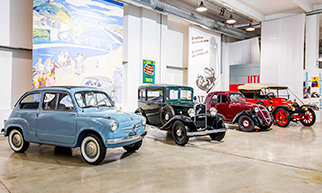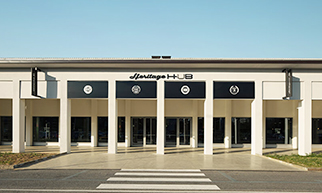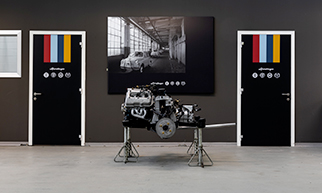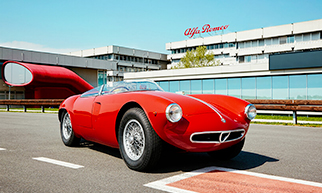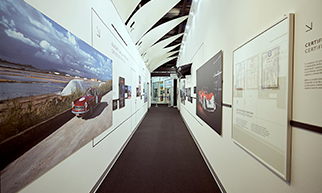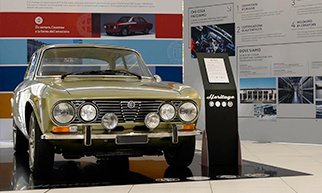From May 24 to 25, in the extraordinary setting of Villa Sucota overlooking Lake Como, Alfa Romeo will be the Official Partner of the 2025 edition of FuoriConcorso, a prestigious event founded in 2019 that every year attracts thousands of collectors, experts and car enthusiasts from all over the world.
The theme selected for this year – “Velocissimo – Italian Race Cars” – aims to tell the story of the beauty and adrenaline of Italian racing cars, those that have fired up generations of enthusiasts and still buzz in the collective unconscious to this day. Specifically for the event, the splendid Villa Sucota will become the “Casa Alfa Romeo,” a space dedicated entirely to Alfa Romeo, a symbol of noble Italian sportiness since 1910. Around 15 extraordinary models will be on show there, some from the Alfa Romeo Museum in Arese and others from private collections.
Among these rarities stands out the 1930 6C 1750 Gran Sport, one of the most famous Alfa Romeos for its unmistakable line (Zagato), six-cylinder engine with compressor and its wide-ranging trophy haul in motorsport, spread out between the Mille Miglia, Targa Florio, Tourist Trophy and many other victories in endurance races. On a model similar to the one on display, the legendary Tazio Nuvolari won the 1930 Mille Miglia, setting an average speed record of 100 km/h across the entire route, in a memorable duel with his teammate, Achille Varzi, also driving a 1750.
The exhibition at Villa Sucota continues with the P2 Grand Prix (1930 evolution), the major star of races in the 1920s that marked Vittorio Jano’s debut in an Alfa Romeo and the first car from the Milan manufacturer with an 8-cylinder engine. Designed from 1923, it made its surprise debut at the "200 Miglia" on the “2nd Cremona Circuit,”, where it won with an average speed of over 158 km/h. It then took part in the 1924 and ’25 Grand Prix, winning the first World Motor Championship with Gastone Brilli-Peri – the first of five world titles for Alfa Romeo. In the following five years, the technical evolution also made it a winner in “extra-formula” competitions, one of the greatest victories among which was in the 1930 Targa Florio, with Achille Varzi. The car on show – from the collections at the National Automobile Museum – is the exact model driven to victory by Varzi in the 1930 “Targa.”
From the golden years of road racing, we move on to the 1960s and the spectacular 1965 Giulia TZ2. An evolution of the previous Giulia TZ, this car is lower, more tapered and aerodynamic, with fiberglass bodywork on a tubular chassis. Designed by Ercole Spada at Zagato, it sports a sleek and muscular line, dominated by the famous truncated tail, which consecrates it as one of the most beautiful racing cars ever. The 1.6 twin-cam engine evolved with double ignition and dry sump, reaching 170 hp and 250 km/h. At its debut in 1965, it won its class at the 1000 km of Monza and went on to take other victories in the same season, including the 12 Hours of Sebring, the Targa Florio and the 1000 km of the Nürburgring. One year later, the TZ2 achieved the same feat at Monza, Sebring, the “Targa” and the “Ring.”
The spotlight also falls on the 1975 33 TT12. It debuted on May 5, 1973 at the “1000 km of Spa-Francorchamps,” when the World Championship for Makes was experiencing a period of great popularity and commitment from the most prestigious manufacturers, including Alfa Romeo with the “Tipo 33” family.
The moniker “33” that debuted in 1967 has now become legendary, while the letters “TT” stand for Telaio Tubulare (‘tubular chassis’; based on its forerunner the 33 TT3 with an 8V engine) and “12” is the `number of cylinders of the new 180° (‘flat’) three-liter V engine that can exceed the threshold of 500 hp. The aesthetics are unmistakable, with its side fins and famous periscope. After a year of development and initial wins in ’74, total domination came in 1975: seven victories out of eight races to win the World Championship for Makes, the fourth overall title in Alfa Romeo history. Legendary drivers such as Merzario, Andretti, Ickx, Vaccarella and many others were seen behind the wheel.
A few steps from Villa Sucota, an exclusive area pays homage to the queens that have made Formula 1 history, including the 1951 Alfa Romeo GP Tipo 159 “Alfetta,” the veritable ruler of the first two World Championships, and the Lancia D50 F.1, one of the greatest sporting achievements in Lancia history. An evolution of the legendary 158 of 1938, the Alfa Romeo GP Tipo 159 “Alfetta,” triumphed with Fangio after the victory by “Nino” Farina in 1950. After the title – the first of five for Fangio – Alfa Romeo officially withdrew from racing to devote itself to the Giulietta. Compared to the 158, the 159's engine was equipped with a two-stage compressor, De Dion rear suspension – the name given to the 1972 Alfetta is based on the adoption of this technical solution – and a more efficient aerodynamic look. The supercharged 1.5-liter inline 8-cylinder engine reaches incredible levels of power: in tests, it even achieved 450 hp, equivalent to 304 hp/liter.
Alongside the Biscione racing car, the public can admire the Lancia D50 in which Gigi Villoresi participated in the 1955 Valentino Grand Prix and which is usually on display at the Heritage Hub in Turin. Its history began in 1953, when Lancia, already having been successful in road racing, decided to also take part in the Formula 1 World Championship. Jano was tasked with designing a single-seater vehicle with the help of the brand’s racing workshop. The vehicle, equipped with a 2.5 liter, 90°-V8 engine, debuted in October 1954 at the Spanish Grand Prix. The D50 stood out for its flawless finishing (unusual for a single-seater race car) and its reduced weight, which was over 50 kg less than its direct rivals. The side petrol tanks on the outside of its body were one of its most unique aesthetic and aerodynamic features, allowing for an improved drag value and exceptional stability in full-tank driving. Success soon followed in 1955 with world-class drivers Alberto Ascari and Gigi Villoresi behind the wheel, including victories at the Naples and Valentino Grand Prix. The relatively limited number of victories, together with the Lancia family’s economic struggles and Alberto Ascari’s tragic death, convinced Lancia to abandon F1. All of the material was left to Ferrari, who won the 1956 World Championship with Manuel Fangio behind the wheel of a modified version of the D50.
Also on show at Villa Sucota will be the new 33 Stradale, a “custom-built” car approved for road use that ensures outstanding performance on the track, designed with no compromises in terms of comfort and ease of use, even on an everyday basis. Unveiled in 2023 and produced in only 33 models (all of which have already been sold), the car represents the return of the legendary 33 Stradale, an icon of the 1960s, reputed by many to be one of the most beautiful cars of all time, and derived directly from the Tipo 33 – once a big name in world motorsport. In brief, Alfa Romeo will be in attendance at FuoriConcorso 2025 with an extraordinary collection of racing masterpieces, each bearing witness to a different era but all united by a common thread, i.e. the overarching quest for timeless beauty and the most exciting performance.
More info on
fuoriconcorso.org